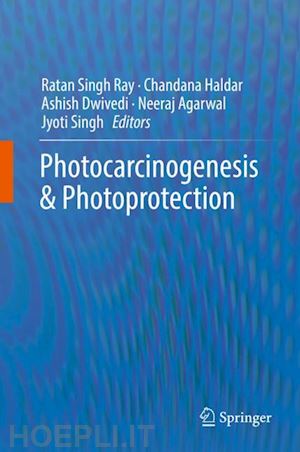
Questo prodotto usufruisce delle SPEDIZIONI GRATIS
selezionando l'opzione Corriere Veloce in fase di ordine.
Pagabile anche con Carta della cultura giovani e del merito, 18App Bonus Cultura e Carta del Docente
This book highlights the problem of UV-R-induced photocarcinogenesis and its molecular mechanism. It covers different photosensitive xenobiotics (drugs, cosmetics, and environmental pollutants) and their photosensitization mechanisms under ambient UV-R exposure. It also summarizes the role of nanotechnology in skin cancer remedies. It provides a brief overview of the various novel nanocarriers for cosmeceuticals like nanoemulsions, liposomes, solid lipid nanoparticles (SLNs), dendrimers, inorganic nanoparticles, nanocrystals, etc., nanotechnology-based cosmeceutical products which are available in the market. It highlights the possible health hazards caused by nanoparticles on exposure of nano-based cosmetics and describes the recent regulatory rules applied to avoid the nanotoxicity.
Module 1. Introduction of Ultra-Violet Radiation.- Module 2. Mechanism of UV-A & UV-B induced mutation in skin.- Module 3. Phototoxicity and Drugs.- Module 4. PAHs & Its Phototoxicity mechanism under UV-R.- Module 5. Photoaging.- Module 6. Epidemiological aspects of photocarcinogenesis.- Module 7. Immunomodulation & photocarcinogenesis.- Module 8. Molecular & Genetic response of human skin under UV-R.- Module 9. Role of personal care products and Phototoxicity.- Module 10. Protective role of phytochemicals against UV-R.- Module 11. Role of nanotechnology in skin cancer remedies.- Module 12. Future Challenges of UV-R induced skin diseases worldwide.
Prof. Ratan Singh Ray is a Senior Principal Scientist & Head, Photobiology Division, CSIR-Indian Institute of Toxicology Research, Lucknow. He is also serving as a Professor in AcSIR, CSIR. He has joined CSIR-IITR in 1991 as a Scientist. He has twenty-six years of research experience in the area of Photosciences. Presently, he is working on photosafety issues of different nanomaterials used in personal care products and identifying novel nanotized phytochemicals for use in cosmetics, hair dyes as well as sunscreen for photosafety against UV-R. He is an active member of various scientific societies including, Bureau of Indian Standards (Cosmetics Sectional Committee PCD 19), India, American Society for Photobiology, USA, Indian Photobiology Society, India, Society of Toxicology, India. He has published many research articles in reputed journals of Photochemistry & Photobiology, Toxicology, Biomaterials, Hazardous materials etc.
Prof. Chandana Haldar is a Head, Department of Zoology, Institute of Science, Banaras Hindu University, Varanasi, India. She has thirty years of research experience in Photosciences. She has edited many books and published more than 200 research papers in the reputed journals of Photosciences. She has been twice awarded Alexander von Humboldt fellowship of Germany to work on the steroid receptors and the pineal gland and immune function (1986-87 &1990-91). Besides three decades of training, research and teaching experience, she has also served as Chairperson and members of various societies, academic councils and administrative bodies in and outside Banaras Hindu University.
Dr. Ashish Diwedi is a Post-Doctoral Scientist in Pineal Research Lab, Department of Zoology, BHU, Varanasi. He has done his Doctoral Research from Photobiology Division, Indian Institute of Toxicology Research (IITR), Lucknow. His Doctorate research work was focused on phototoxicity assessment of different therapeutic drugs andenvironmental pollutants. He has ten years of research experience in Photosciences and published many papers in reputed journals of Photochemistry & Photobiology, Toxicology, Biomaterials, Hazardous materials etc.
Dr. Neeraj Agarwal is working as a Research Associate in NCI-designated University of Colorado Comprehensive Cancer Center, Aurora, CO, USA. Previously, he has completed his Ph.D. (2001 to 2007) from Photobiology, Division of Indian Institute of Toxicology Research (IITR), Lucknow. His work was focused on determining the phototoxic potential of commonly used therapeutic drugs and their mechanism of action. He has published seven research papers and presented his work at various conferences. He has received best poster award in 2002 for the work related to ciprofloxacin phototoxicity. In 2007, he joined Louisiana Health Sciences Center (LSUHSC), New Orleans, USA as a Postdoctoral Researcher and worked for five years towards understating the role of MTBP protein in osteosarcoma metastasis and also on identifying and characterizing the cancer stem cells in osteosarcoma. He has received Scientific Excellence Award and was invited to present his work in Cancer Center Retreat in 2010. Till now, he has published 18 research articles in reputed international journals with high impact factors, including Cancer Research, Oncogene, Cell Death and Differentiation, Clinical Cancer Research, and Photochemistry and Photobiology.
Jyoti Singh is presently pursuing her doctorate research from CSIR-Indian Toxicology Research Institute, Lucknow under the supervision of Dr. Ratan Singh Ray, Head of Photobiology Division. She did her Masters in Forensic science from Bundelkhand University, Jhansi. She is a member of Indian Photobiology Society, India. She has published a book chapter and research papers in reputed journals of International journal of biochemistry and cell biology, Toxicology letters, Biomaterials, Hazardous materials etc.











Il sito utilizza cookie ed altri strumenti di tracciamento che raccolgono informazioni dal dispositivo dell’utente. Oltre ai cookie tecnici ed analitici aggregati, strettamente necessari per il funzionamento di questo sito web, previo consenso dell’utente possono essere installati cookie di profilazione e marketing e cookie dei social media. Cliccando su “Accetto tutti i cookie” saranno attivate tutte le categorie di cookie. Per accettare solo deterninate categorie di cookie, cliccare invece su “Impostazioni cookie”. Chiudendo il banner o continuando a navigare saranno installati solo cookie tecnici. Per maggiori dettagli, consultare la Cookie Policy.